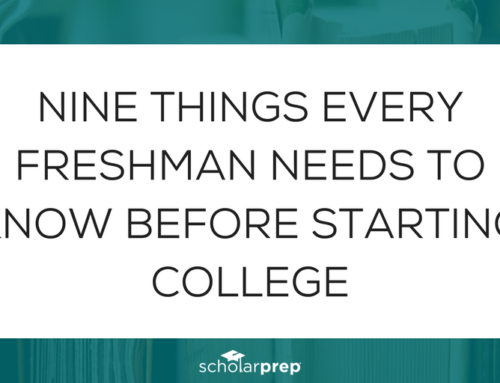This is a guest blog post written by our friends at Higher Scores Test Prep, a family-owned and operated company. They are dedicated to treating each of their clients as a member of their own family. They know how important these exams are to a student’s future and are honored when families choose to prepare for the ACT & SAT with them. We encourage you to learn more about Higher Scores Test Prep! DISCLAIMER: This post contains affiliate links, which means that if you purchase one of the products linked, we’ll receive a small commission. You will NOT be charged any additional fees if purchasing through an affiliate link.
 If you are the parent of a college-bound high school student, you know that figuring out when to take the ACT can be a tough task. Trying to fit in ACT prep too can be next to impossible.
If you are the parent of a college-bound high school student, you know that figuring out when to take the ACT can be a tough task. Trying to fit in ACT prep too can be next to impossible.
Students are so busy these days. It’s hard to fit everything in, but I’ll share 3 big questions that will guide you towards the best, low-stress testing options for your student.
By the end of this article, you will know exactly when your student should first take his or her first ACT that is strategically chosen for massive success.
When should you take the ACT?
There are a lot of different philosophies on what time is the best time for students to take the ACT.
Historically, most high school student the spring of their junior year. And, while the tradition has held somewhat, most families realize that their students have a lot of flexibility when it comes to testing.
In fact, there are six ACT test dates you can choose from each year and students can begin testing as early as 8th grade – although, I definitely don’t recommend getting started that early!
Since it’s completely up to individual families to decide when their student should take the ACT, what should you take into account to ensure that your family makes the best, low-stress decisions so your student can get his or her higher ACT scores as quickly as possible and with as little stress as possible?
Let’s begin with the end in mind!
What’s the ultimate goal?
The goal for most families that I work with is to have scores that will help their students get into college and earn cash for college too.
In order to free up time the summer before senior year so students can get a jump on their applications for colleges and scholarships, I like every student to have prepared for and taken 2 back-to-back ACTs so they’ll have scores they’re proud of in hand while filling out applications.
Higher Scores’ Golden Rule of Testing:
Students should prepare for and take 2 official ACT or SAT exams no later than June of their junior year.
Why should you take the ACT on 2 back-to-back test dates?
I believe students should take back-to-back test dates after they prepare for the ACT so they have 2 chances to do their best work on the exam and to do it before they forget what they learned in prep.
ACT prep has to be a high-octane, full focus affair. Students can’t dawdle through it. There’s too much to learn. And, once they’ve invested that time, energy, and focus, it’s imperative that they put it to maximum use.
The first official ACT experience should come right on the heels of a prep course wrapping up.
Breaks between prep and test day diminish students’ results. Your family shouldn’t invest in test prep and only give your student 1 chance to put it to good use. That puts too much pressure on the student when he or she only has 1 make-or-break chance to do well.
One Chance = Stress = Lower ACT Scores
By registering for back-to-back test dates (for instance, the September and October ACT), students can fully prepare for the first ACT. Once they’re done, they can take a short break while they wait for their scores to roll in. After assessing their first test day performance, they can dive in for another week or two of brush-up prep before they take their next ACT.
By testing back-to-back, students won’t have waited so long that they’ve forgotten everything they learned. That said, they’ll also have a little distance from intense prep which can revitalize motivation and help students see the test more clearly the second time around.
You may opt to test a 3rd or 4th time later on. That’s more than welcome; however, you’ll have achieved most of your score improvement over a 3 or 4 months interval rather than over 6 months or a year.
Anything above the initial push is refinement and nuanced work, rather than the initial heavy lifting.
This is why I give my ACT Complete Package students full access to the course for 18-months. They can come back to brush up any time they need to at no extra charge.
3 Guiding Questions
So, now that we’re clear on how many exams students should take and the deadline by which they should take them in order to reduce stress, how do you decide when to test?
There are 3 questions that I ask all of my prospective families as I help them determine the perfect, low-stress testing timeline for their student.
- What level math is your student studying?
- What does your family’s calendar look like?
- What grade is your student in?
Let’s dive in…
1. What level math are is your student studying?
The ACT covers up everything from arithmetic to precalculus in the math portion of the exam. Knowing what level math your student is currently studying can help me quickly determine whether or not you should wait to complete more coursework or begin prepping right away.
Ideally, I like students to be at least halfway through Algebra 2 before they take the ACT.
Remember the Golden Rule, though. The most important thing is that students take 2 exams by June of their junior year.
If your student won’t be in or completely through Algebra 2 by then, he or she will still need to take the ACT before the end of the school year.
2. What does your family’s calendar look like?
Does your child play a fall sport? Is he or she involved in the spring musical? Do they volunteer on a seasonal basis with a favorite organization? Will they be taking AP or IB exams in the spring?
The reason testing and test prep has such a bad reputation is that families don’t realize how flexible it can be. Test prep doesn’t have to overlap with your student’s busy season if you plan well.
Here are a few things to keep in mind as you consider your schedule…
Test prep takes more time than testing itself.
When planning which ACT test date to take, back up 8-12 weeks from the actual date. What does your student’s schedule look like before the test date?
So often, we focus on the test date itself, but – ideally – that’s the finish line. The marathon started 2-3 months earlier when your family came together to choose a test prep strategy.
Keep this in mind as you plan your way forward.
Siblings’ activities and family events may impact your testing student’s schedule.
Once I worked with a tutoring student who wasn’t involved in a spring activity, but his sister was travelling for national competitions and he went along. The problem was that the family forgot to consider the sister’s schedule when planning his test prep.
Working around her competition calendar made his prep schedule very hectic.
That was one of the experiences that convinced me it was time to create a test prep program that was flexible and mobile – which is why I founded Higher Scores Test Prep.
That said, if students are going to be travelling for a sibling’s or family events, you should consider that before committing to a test date.
Spring ACT test dates are terribly stressful for AP and IB students.
Is your student taking 2 or 3 AP or IB exams in the spring? If so, he or she should avoid taking the ACT in April and June.
I love testing (yes, really – #dontjudge) and the idea of APs, IBs, and ACTs all in the same month makes me panicky.
If your child in accelerated classes, chances are he or she can get started with testing a lot earlier than spring of his or her junior year. If that’s the case, do so.
Your family’s stress level will be so much lower in the spring if you do.
3. What grade is your student in?
It may surprise you that this is the last question I ask. The reason I wait is because it is actually least important in the grand scheme of things.
Students’ ACT scores are valid for 5 years from the date of testing. That means, if your student’s academics (math in particular) are ready, he or she could test as an 8th grader and be done with testing before heading to high school.
I wouldn’t recommend testing in 8th grade, but it’s a possibility.
I believe the ideal window for testing opens in winter of sophomore year and closes in fall of senior year.
That’s why students have access to my ACT Complete Package prep course for 18 months. I know some students are going to take advantage of that early start, which is great. But, if they want to dive back in during the fall of their senior year to add an extra point or two once they’ve finalized their college list, they have the flexibility to do so.
After all, 1 extra ACT point can translate to thousands of dollars in merit aid!
As your family is deciding when your student should take the ACT, consider where he or she is in this optimum window of winter of sophomore year to fall of senior year.
Keeping the first 2 questions in mind, your student should plan to take the ACT as early as possible within this range.
Your student may be a great candidate for spring of junior year. Maybe fall of junior year is better because of his or her commitments in the spring. Or maybe, just maybe, he or she can get started as early as second semester sophomore year.
Keep in mind that there is no right answer. There is an answer that best fits your schedule.
As the wise knight from Indiana Jones and the Last Crusade advised Indy: Choose wisely!
Once you’ve decided the season you’ll take the test in, put the actual ACT test dates side-by-side with your calendar and make 100% sure that there are no conflicts.
If there aren’t any conflicts, congratulations! You’re set to test!












